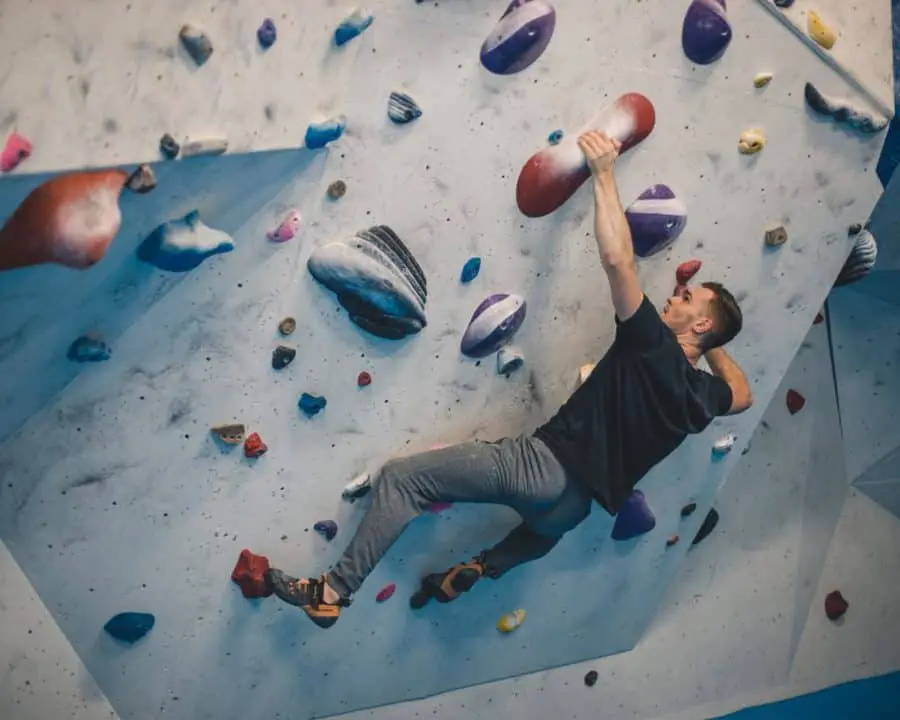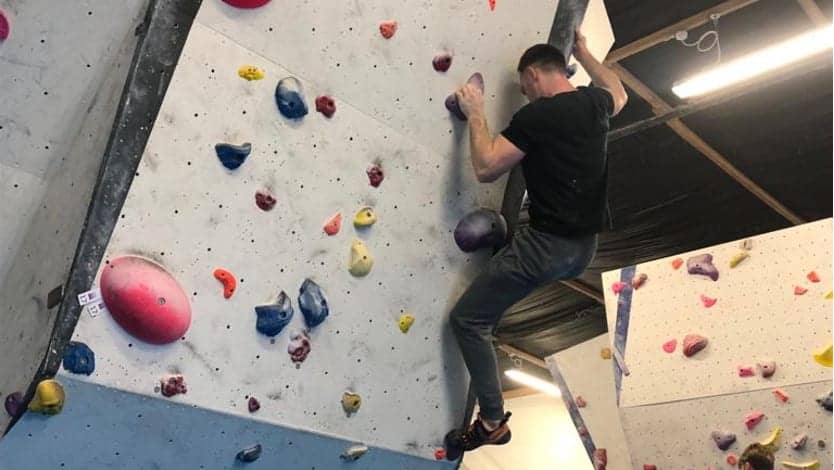
If you’re a frequent rock climber you may be thinking, is rock climbing every day bad? It’s hard to know the best strategy and routine to get the best technique progression while also giving your body enough recuperation. This article will not only outline why climbing everyday is bad for the majority of climbers, but also focus on the best weekly routine to give you maximum gains and minimal injuries.
So, is rock climbing everyday bad? Climbing everyday can cause long term and short term injuries, so it is not advised. The amount of days you should climb per week depend on how advanced you are. The more advanced you are, the more frequently you’ll need to climb to see progression. Professional climbers usually climb 6-7 days per week, but they also have nutrition coaches and physiotherapists on standby if anything were to go wrong. Even if you did have this type of help, it is not advised to train 6-7 times a week unless you are an advanced climber.
Page Jumps
- How Bad is it Really to Rock Climb Everyday?
- How to Safely Increase the Amount of Days Per Week You Climb
- How Often Should You Climb?
- How Should You Climb to Avoid Injuries and Speed Up Recovery Rate?
- Nutritional Advice and Home Physiotherapy to Speed Up Muscle Recovery
- Should You Increase the Amount of Days Per Week You Climb?
- What Should You Do on Your Rest Days to Help Your Overall Climbing?
- Related Questions
How Bad is it Really to Rock Climb Everyday?
The main reason why it’s bad to climb everyday is because it puts a lot of stress on the flexor tendons in your fingers. If you over-train your flexor tendons, it’s only a matter of time before they snap. There are ways to strengthen these tendons so that you can climb more frequently – this takes time and patience to achieve and is best done by using a hangboard.
What people forget about climbing is that it’s a mix of a fast twitch and slow twitch sport. It requires the endurance of slow twitch muscle fibres and the explosive power of fast twitch muscles fibres. This then means your body needs more time to heal after a hard session. Of course, as your body gets used to the exercise, the healing process will become much easier. Professional climbers usually climb 6-7 days per week, and a couple of those days are generally slower paced where they rest more between climbs and/or climb easier grades.
Your body will usually tell you how it feels after a session. I used to be very injury prone, throughout all the sports I’ve done. And it’s taken me this long to realise I was training too hard and too often. As long as I put in the right warm up, I rarely get injuries because I listen to my body before I think about going climbing. Everybody is different, however. Some people can train for longer without getting as many injuries.

How to Safely Increase the Amount of Days per Week You Climb
If you want to increase the amount of days per week you climb then you need to make sure you’re doing it in a safe way. There is no point risking any short term or even long term injuries just because you want to progress faster.
The key to climbing as often as possible is to limit the length of the session so there’s not too much strain on your body. The higher the intensity of the exercise, the less length of time you should train. Once you’ve focused on that it’s time to move onto your diet.
Warm up before a session and cool down afterwards. This reduces lactic acid build up, prevents injury, and helps overall body recovery once the session is over.
You need to train different aspects every time you climb. For example, slab climbing one day, and cave climbing the next. You can’t just focus on one aspect constantly, otherwise you’ll be putting too much stress on the same muscles.
If you feel like your body is a little too over trained then you need to reduce the amount you train, maybe have a few days off now, and then go back to your normal routine once your body feels better.
How Often Should You Climb?
If you are beginner you should be climbing 3 days a week maximum, having each day spaced out by at least another days (e.g. Climb Monday, Wednesday, Friday). This is so you have enough time to heal muscles you’re not used to using.
Advanced climbers should train 4-5 times a week if they want to see progression. 1-2 of the days should be slower paced.
How Should You Climb to Avoid Injuries and Speed Up Recovery Rate?
When you’re on the climbing wall you should always be focusing first on technique, then on strength. If you send a climb but you used near to no technique then there’s nothing special about that. Of course, every climber needs a certain amount of strength to ascend certain routes, but technique is your most vital asset on the wall. If you’re using strength then not only are you more likely to get injured but it’s also going to mean your recovery time will take a lot longer. Improve your technique by climbing on your normal grade climbs, but instead of focusing on sending it, focus on perfect technique for every transition. This will not only allow you to train MORE, but also improve your climbing ability overall very quickly.
Nutritional Advice and Home Physiotherapy to Speed Up Muscle Recovery
There are many foods you need to eat to make sure your diet is full of the nutrition it requires to speed up the recovery of your body after a climbing session. Your body needs omega-3 and 6 fatty acids for inflammation recovery (tuna, salmon, trout), protein for muscle recovery (chicken, fish, beans), and calcium for bone recovery (leafy greens such as broccoli, nuts, tofu, milk). You’ll also need to get some vitamin-D to help the absorption of nutrients (the Sun, tuna, salmon, halibut, mushrooms, vitamin D3 supplements). Make sure you get enough sleep, this helps massively with overall health and body recovery. I would also recommend up to a teaspoon per day of turmeric and ginger for their anti-inflammatory benefits. Turmeric is also full of anti-oxidants which speed up healing.
If you feel like you’ve pushed yourself a bit too far in training, or you’d just like to speed up muscle and joint recovery then there are many ways to do this. A deep tissue massage is one of the best all-natural ways to increase blood flow to a specific area and therefore speed up the rate of recovery. Personally, I get a 30 minute sports massage at least once every 6 weeks. If you would rather do this at home, get yourself a trigger point foam roller (click for price on Amazon) and/or a lacrosse ball (click for price on Amazon). These two items have helped me immensely with sore muscles. You should also consider using a bag of ice wrapped in a thin cloth on the affected part of your body (or just take an ice bath if your whole body is sore). If you have any injuries it’s best to use the RICE method – rest, ice, compression, elevation. Rest your injury, ice it up, compress it, then elevate the body part above your heart if possible.
Yoga is also a fantastic way to help your body recover. By improving the flexibility of your joints and muscles, not only will they heal faster but there will be less chance of injury.
Should You Increase the Amount of Days Per Week you Climb?
When thinking about increasing the amount of days per week you climb you have to think about three factors. Are you progressing fast enough? How sore do you feel throughout the week due to the amount you currently train? And how often do you get injured? If you’re not progressing very fast, you don’t feel very sore throughout the week, and you aren’t injury prone then I’d say you need to increase the days per week that you climb. If you aren’t seeing any progression but you are also injury prone and/or quite sore throughout the week you might want to consider trying the methods I’ve gone through in this article to speed up your rate of recovery and reduce chance of injury.
What Should You Do on Your Rest Days to Help Your Overall Climbing?
Depending on how sore you are on your rest days, there’s a few things you can do to help improve your climbing experience even when you’re at home. We’ve already talked about how to improve your recovery rates, these will help improve your overall climbing. Yoga, good nutrition, resting your sore muscles and joints, ice, and deep tissue massage therapy are great things to do on your rest days. Also try hangboarding if your fingers aren’t too sore. Completing a daily hangboard routine can take your from a mediocre climbing to a great climber in the matter of a month if you do it right. I’ve written a hangboard exercise in this article if you’d like to see it. Plus you can make a DIY hangboard with a doorway pull-up bar (check out the YouTube video below).
Related Questions
How long should a rock climbing session last? A high intensity session should last 1-1.5 hours. A medium intensity session should last 1.5-2.5 hours. A slower session should last 2.5-5 hours.
